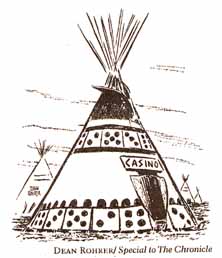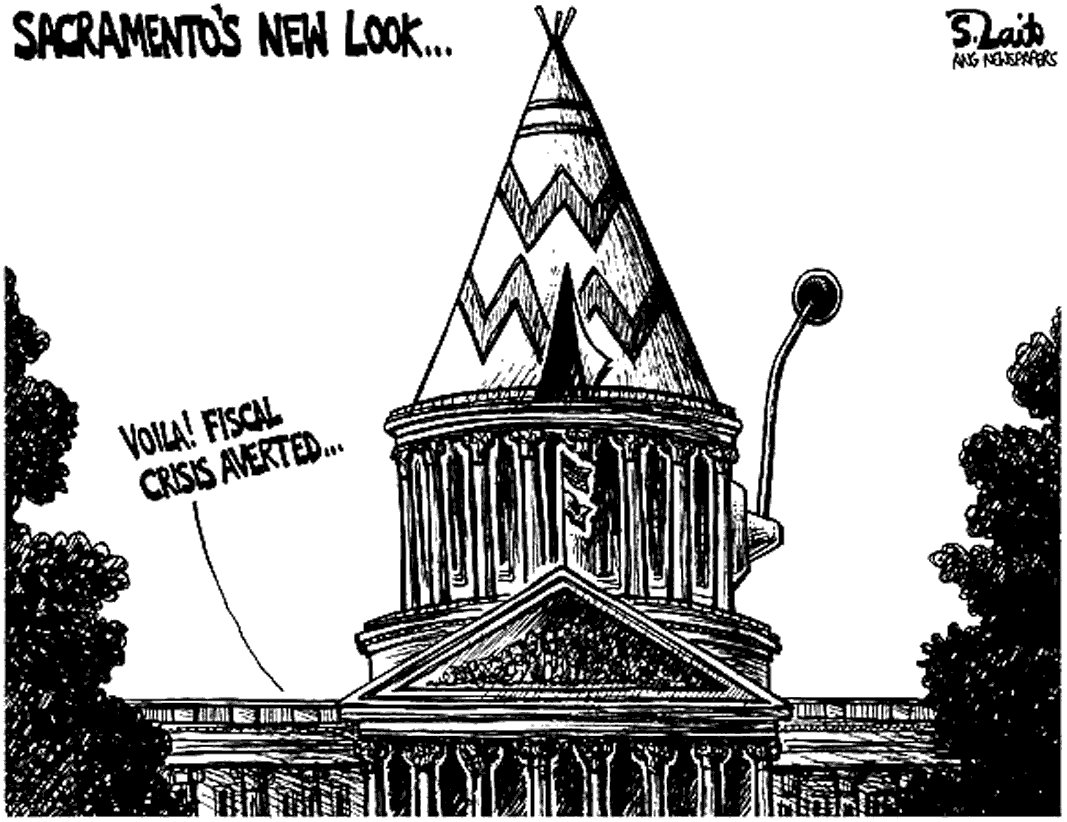

A good article explains the "rich Indian" stereotype:
Tribes look to debunk gaming myths
Stereotypes prove to be damaging
L. A. Franck 2/7/2006
The congressional aide was quite candid about it, Tim Horan recalls. Meeting people from a non-gaming tribe was a novelty if not a shock.
"They were not accustomed to hearing about and seeing-we brought lots of pictures-the kind of poverty and substandard housing and living conditions that we deal with daily," says Horan, who is Executive Director of Round Valley Indian Housing Authority in Northern California, recalling a visit to Washington this past February.
Being that this case involved a Southern California district where successful gaming tribes are locally familiar, encountering that perception was not a surprise, comments Horan. But nationwide, despite the facts that a majority of tribes don't even have gaming, and that only a handful of the gaming tribes have become rich, myth has it that Indian Country is awash in money, according to concerned parties.
"A Terrible Injustice"
"I run up against that notion all the time," says David Kennedy, founder of the Wieden + Kennedy ad agency in Portland, Oregon, and a board member of the American Indian College Fund. He calls the myth "our biggest competitor" in fundraising. Rick Williams, President of the Fund, says the proliferation of the myth goes hand-in-hand with the mainstream American tendency to regard Indian tribes as one generic entity, not as separate sovereign nations.
"One of every three people we deal with-donors and the general public-will ask the question: 'Why aren't the tribes giving more?' Probably another third want to ask the question but are too polite." Their premise-that all tribes are the same-is faulty, Williams says, exposing it thus: "In the early 1970s, was then-booming Las Vegas expected to bail out near-bankrupt New York City?"
"Broadbrushing is dangerous," says Deborah Webster, Tribal Representative for Enterprise, an operating foundation with significant involvement in Indian Country. "If you characterize everybody, it's not appropriate. It's not true. Tribes are as diverse as cities and towns across the U.S."
"The myth does a terrible injustice to tribal people, who are struggling behind all other racial and ethnic groups on every measure of economic and housing standards," says Gary L. Gordon, Executive Director of the National American Indian Housing Council.
Reality: Desperate Housing Conditions
Some of those measures are as follows: 90,000 Indian families remain underhoused or homeless, and 200,000 housing units are needed immediately in Indian Country, as the U.S. Commission on Civil Rights stated in a 2003 report. According to Census data, in tribal areas, 14.7 percent of homes are overcrowded, compared to 5.7 percent in the general U.S. population; on lack of complete plumbing facilities, the numbers are 11.7 percent and 1.2 percent respectively. More than 1 in 10 tribal homes don't have a kitchen.
Conditions such as these are familiar enough to most non-gaming tribes, but even modestly successful gaming tribes such as the Umatilla in Oregon, after a decade of casino operations, still face rampant overcrowding, according to Barbara Roloff, Executive Director of Umatilla Indian Housing Authority.
The Malignancy of the Myth
Further, the tribe sees public perceptions come back in wildly exaggerated form, according to Marcus Luke II, Umatilla Homeownership Counselor.
"Many non-Native people think just because we're Native American we have money," he says. "When we try to get donations, people say: 'You already have money, you have the casino.'"
A certain major fast-food corporate foundation gives scholarships to students of all ethnic groups-except Native American, says Williams.
"Someone on their board said: 'Indian children go to school free, and they have all that money from gaming; they don't need our help'. So we've been summarily dismissed. This is a perfect example of a mainstream myth about Indians causing harm."
"The pervasive and persistent myth exacerbates the challenge for Indian housing professionals, fundraisers, and advocates, who put forth the reality that tribal communities have severe housing need and try to make the case for more funding," comments Gordon. "They often must start from less than square one as they encounter people disposed to question why there would be such concerns."

Gaming Tribes: 42% Unemployment and Marginal Benefits for Housing
Given the remoteness of the lands to which most tribes were historically displaced, the economic development needed to sustain housing is difficult, and even gaming is far from a shoo-in for success.
As NAIHC reported last year, among 562 federally recognized tribes, of the 224 that have gone into gaming (operating 354 facilities), 90 (40 percent) make less than 1 percent of the industry's gross revenue. Two-thirds of the gaming operations account for just 10 percent of the overall revenue with annual gross revenue of $25 million or less. The remaining one-third account for 90 percent of the revenue.
In a recent NAIHC survey of its members (65 responding), among 30 respondents representing gaming tribes, 18 said none of their gaming revenues go into housing, 4 said it is in the 6-10 percent range, and none put it above 10 percent. For many gaming tribes, the primary benefit is employment, as they now provide 400,000 jobs (75 percent of them to non-Indians). The Umatilla have been able to bring their unemployment rate from 47 percent in 1994 down to 17 percent now, according to Roloff. However, gaming tribes overall have an unemployment rate of 42 percent-practically the same as that of non-gaming tribes: 43 percent. And none of Umatilla's gaming revenues go into housing, according to Roloff.
"There's only so much revenue to go around, and so many essential tribal services and programs," she says, explaining also that housing gets its Native American Housing Block Grant and is expected to leverage it to tap other funding sources.
"Obviously, a few gaming tribes have been able to tackle their housing and other needs, but throughout Indian Country the volume of gaming revenue has been enough to produce only a slight benefit overall," says Gordon. "The needs for most tribes are significant in many areas, and it will take quite some time before the revenues can be expected to adequately address these needs, if ever."
Currently, for most gaming tribes, "profit" does not enter the picture; rather, it's about maintaining basic services that are inadequately supported by agencies that are obligated by treaties and laws to do so, says Enterprise's Webster.
"We're actually working in Indian Country, so we understand. Other foundations may have a more peripheral view, and may read only about the Pequots and get the idea that all tribes are rich from gaming."
Dispelling the Myth
Ignorance is the main barrier, the concerned parties agree: not only about gaming and living conditions for Indian people, but also about tribal sovereignty, the ignorance of which leads to a skewed view of tribe-to-tribe relations and expectations thereof.
"I believe it is imperative that we work to educate the general public about Indian people and their true status in America," says Williams. "You have to be able to provide some really good information," advises Williams. At the heart of the matter is helping people understand that tribes are sovereign nations, with separate governments like each of the United States.
Jane DeMarines contributed to this article, which originally appeared in the Native American Housing News.
More on rich Indians
The myth of the rich Indian
Related links
Greedy Indians
Stereotype of the Month contest
|
. . . |

|
All material © copyright its original owners, except where noted.
Original text and pictures © copyright 2007 by Robert Schmidt.
Copyrighted material is posted under the Fair Use provision of the Copyright Act,
which allows copying for nonprofit educational uses including criticism and commentary.
Comments sent to the publisher become the property of Blue Corn Comics
and may be used in other postings without permission.